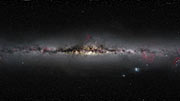Press Release
The Smoky Pink Core of the Omega Nebula
4 January 2012
A new image of the Omega Nebula, captured by ESO's Very Large Telescope (VLT), is one of the sharpest of this object ever taken from the ground. It shows the dusty, rose-coloured central parts of this famous stellar nursery and reveals extraordinary detail in the cosmic landscape of gas clouds, dust and newborn stars.
The colourful gas and dark dust in the Omega Nebula serve as the raw materials for creating the next generation of stars. In this particular section of the nebula, the newest stars on the scene — dazzlingly bright and shining blue-white — light up the whole ensemble. The nebula's smoky-looking ribbons of dust stand in silhouette against the glowing gas. The dominant reddish colours of this portion of the cloud-like expanse, arise from hydrogen gas, glowing under the influence of the intense ultraviolet rays from the hot young stars.
The Omega Nebula goes by many names, depending on who observed it when and what they thought they saw. These other titles include the Swan Nebula, the Horseshoe Nebula and even the Lobster Nebula. The object has also been catalogued as Messier 17 (M17) and NGC 6618. The nebula is located about 6500 light-years away in the constellation of Sagittarius (The Archer). A popular target of astronomers, this illuminated gas and dust field ranks as one of the youngest and most active stellar nurseries for massive stars in the Milky Way.
The image was taken with the FORS (FOcal Reducer and Spectrograph) instrument on Antu, one of the four Unit Telescopes of the VLT. In addition to the huge telescope, exceptionally steady air during the observations, despite some clouds, also helped make the crispness of this image possible [1]. As a result this new picture is among the sharpest of this part of the Omega Nebula ever taken from the ground.
This image is one of the first to have been produced as part of the ESO Cosmic Gems programme [2].
Notes
[1] The "seeing" — a term astronomers use to measure the distorting effects of Earth's atmosphere — on the night of the observations was very good. A common measure for seeing is the apparent diameter of a star when seen through a telescope. In this case, the measure of seeing was an extremely favourable 0.45 arcseconds meaning little blurring and twinkling of the object of interest.
[2] The ESO Cosmic Gems programme is an outreach initiative to produce images of interesting, intriguing or visually attractive objects using ESO telescopes, for the purposes of education and public outreach. The programme makes use of small amounts of observing time, combined with otherwise unused time on the telescopes’ schedules so as to minimise the impact on science observations. All data collected may also be suitable for scientific purposes, and are made available to astronomers through ESO’s science archive.
More information
The year 2012 marks the 50th anniversary of the founding of the European Southern Observatory (ESO). ESO is the foremost intergovernmental astronomy organisation in Europe and the world’s most productive astronomical observatory. It is supported by 15 countries: Austria, Belgium, Brazil, Czechia, Denmark, France, Finland, Germany, Italy, the Netherlands, Portugal, Spain, Sweden, Switzerland and the United Kingdom. ESO carries out an ambitious programme focused on the design, construction and operation of powerful ground-based observing facilities enabling astronomers to make important scientific discoveries. ESO also plays a leading role in promoting and organising cooperation in astronomical research. ESO operates three unique world-class observing sites in Chile: La Silla, Paranal and Chajnantor. At Paranal, ESO operates the Very Large Telescope, the world’s most advanced visible-light astronomical observatory and two survey telescopes. VISTA works in the infrared and is the world’s largest survey telescope and the VLT Survey Telescope is the largest telescope designed to exclusively survey the skies in visible light. ESO is the European partner of a revolutionary astronomical telescope ALMA, the largest astronomical project in existence. ESO is currently planning a 40-metre-class European Extremely Large optical/near-infrared Telescope, the E-ELT, which will become “the world’s biggest eye on the sky”.
Links
Contacts
Richard Hook
ESO, La Silla, Paranal, E-ELT and Survey Telescopes Public Information Officer
Garching bei München, Germany
Tel: +49 89 3200 6655
Cell: +49 151 1537 3591
Email: rhook@eso.org
About the Release
| Release No.: | eso1201 |
| Name: | M 17, Messier 17, NGC 6618, Omega Nebula |
| Type: | Milky Way : Nebula : Type : Star Formation |
| Facility: | Very Large Telescope |
| Instruments: | FORS2 |
Our use of Cookies
We use cookies that are essential for accessing our websites and using our services. We also use cookies to analyse, measure and improve our websites’ performance, to enable content sharing via social media and to display media content hosted on third-party platforms.
ESO Cookies Policy
The European Organisation for Astronomical Research in the Southern Hemisphere (ESO) is the pre-eminent intergovernmental science and technology organisation in astronomy. It carries out an ambitious programme focused on the design, construction and operation of powerful ground-based observing facilities for astronomy.
This Cookies Policy is intended to provide clarity by outlining the cookies used on the ESO public websites, their functions, the options you have for controlling them, and the ways you can contact us for additional details.
What are cookies?
Cookies are small pieces of data stored on your device by websites you visit. They serve various purposes, such as remembering login credentials and preferences and enhance your browsing experience.
Categories of cookies we use
Essential cookies (always active): These cookies are strictly necessary for the proper functioning of our website. Without these cookies, the website cannot operate correctly, and certain services, such as logging in or accessing secure areas, may not be available; because they are essential for the website’s operation, they cannot be disabled.
Functional Cookies: These cookies enhance your browsing experience by enabling additional features and personalization, such as remembering your preferences and settings. While not strictly necessary for the website to function, they improve usability and convenience; these cookies are only placed if you provide your consent.
Analytics cookies: These cookies collect information about how visitors interact with our website, such as which pages are visited most often and how users navigate the site. This data helps us improve website performance, optimize content, and enhance the user experience; these cookies are only placed if you provide your consent. We use the following analytics cookies.
Matomo Cookies:
This website uses Matomo (formerly Piwik), an open source software which enables the statistical analysis of website visits. Matomo uses cookies (text files) which are saved on your computer and which allow us to analyze how you use our website. The website user information generated by the cookies will only be saved on the servers of our IT Department. We use this information to analyze www.eso.org visits and to prepare reports on website activities. These data will not be disclosed to third parties.
On behalf of ESO, Matomo will use this information for the purpose of evaluating your use of the website, compiling reports on website activity and providing other services relating to website activity and internet usage.
Matomo cookies settings:
Additional Third-party cookies on ESO websites: some of our pages display content from external providers, e.g. YouTube.
Such third-party services are outside of ESO control and may, at any time, change their terms of service, use of cookies, etc.
YouTube: Some videos on the ESO website are embedded from ESO’s official YouTube channel. We have enabled YouTube’s privacy-enhanced mode, meaning that no cookies are set unless the user actively clicks on the video to play it. Additionally, in this mode, YouTube does not store any personally identifiable cookie data for embedded video playbacks. For more details, please refer to YouTube’s embedding videos information page.
Cookies can also be classified based on the following elements.
Regarding the domain, there are:
- First-party cookies, set by the website you are currently visiting. They are stored by the same domain that you are browsing and are used to enhance your experience on that site;
- Third-party cookies, set by a domain other than the one you are currently visiting.
As for their duration, cookies can be:
- Browser-session cookies, which are deleted when the user closes the browser;
- Stored cookies, which stay on the user's device for a predetermined period of time.
How to manage cookies
Cookie settings: You can modify your cookie choices for the ESO webpages at any time by clicking on the link Cookie settings at the bottom of any page.
In your browser: If you wish to delete cookies or instruct your browser to delete or block cookies by default, please visit the help pages of your browser:
Please be aware that if you delete or decline cookies, certain functionalities of our website may be not be available and your browsing experience may be affected.
You can set most browsers to prevent any cookies being placed on your device, but you may then have to manually adjust some preferences every time you visit a site/page. And some services and functionalities may not work properly at all (e.g. profile logging-in, shop check out).
Updates to the ESO Cookies Policy
The ESO Cookies Policy may be subject to future updates, which will be made available on this page.
Additional information
For any queries related to cookies, please contact: pdprATesoDOTorg.
As ESO public webpages are managed by our Department of Communication, your questions will be dealt with the support of the said Department.



